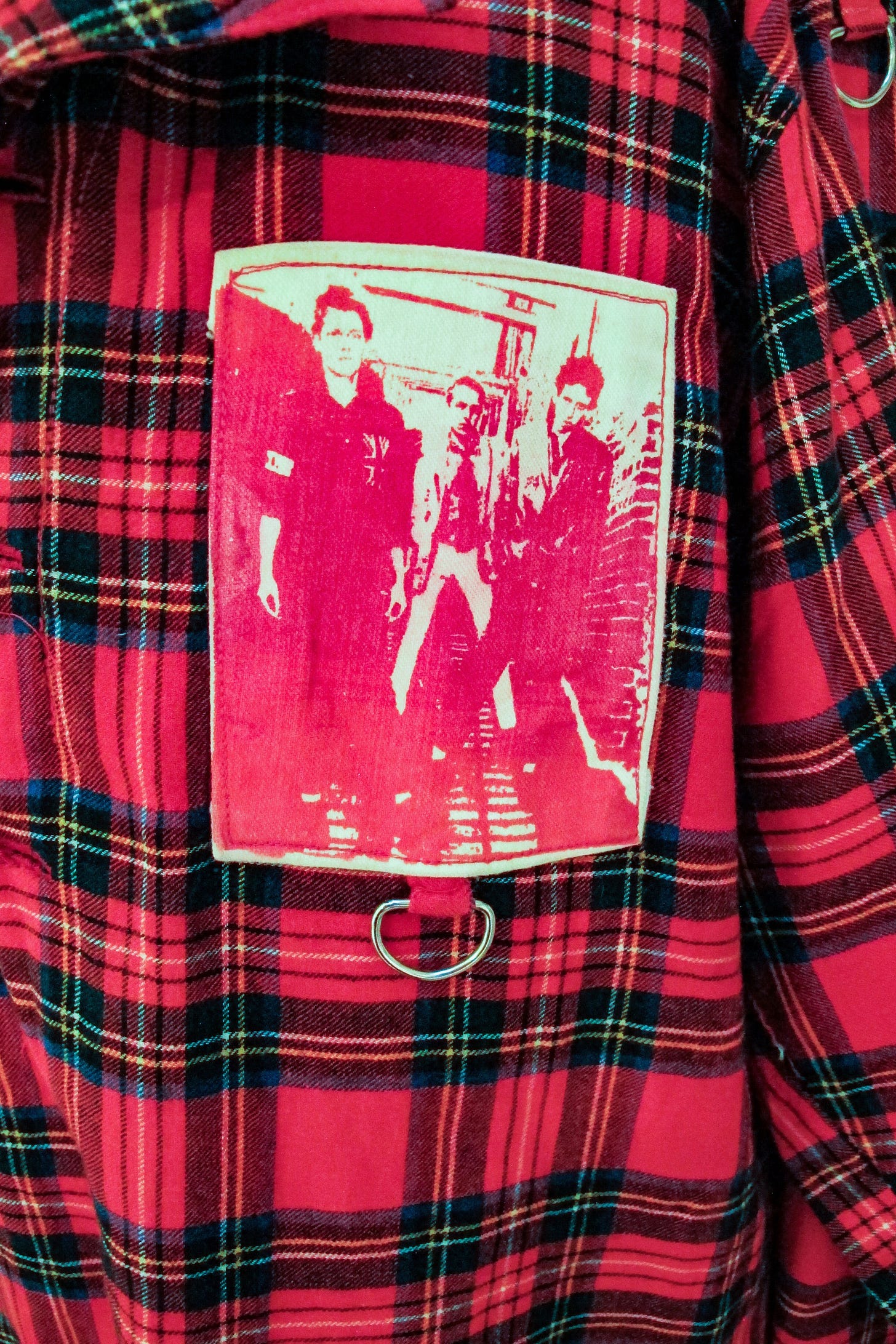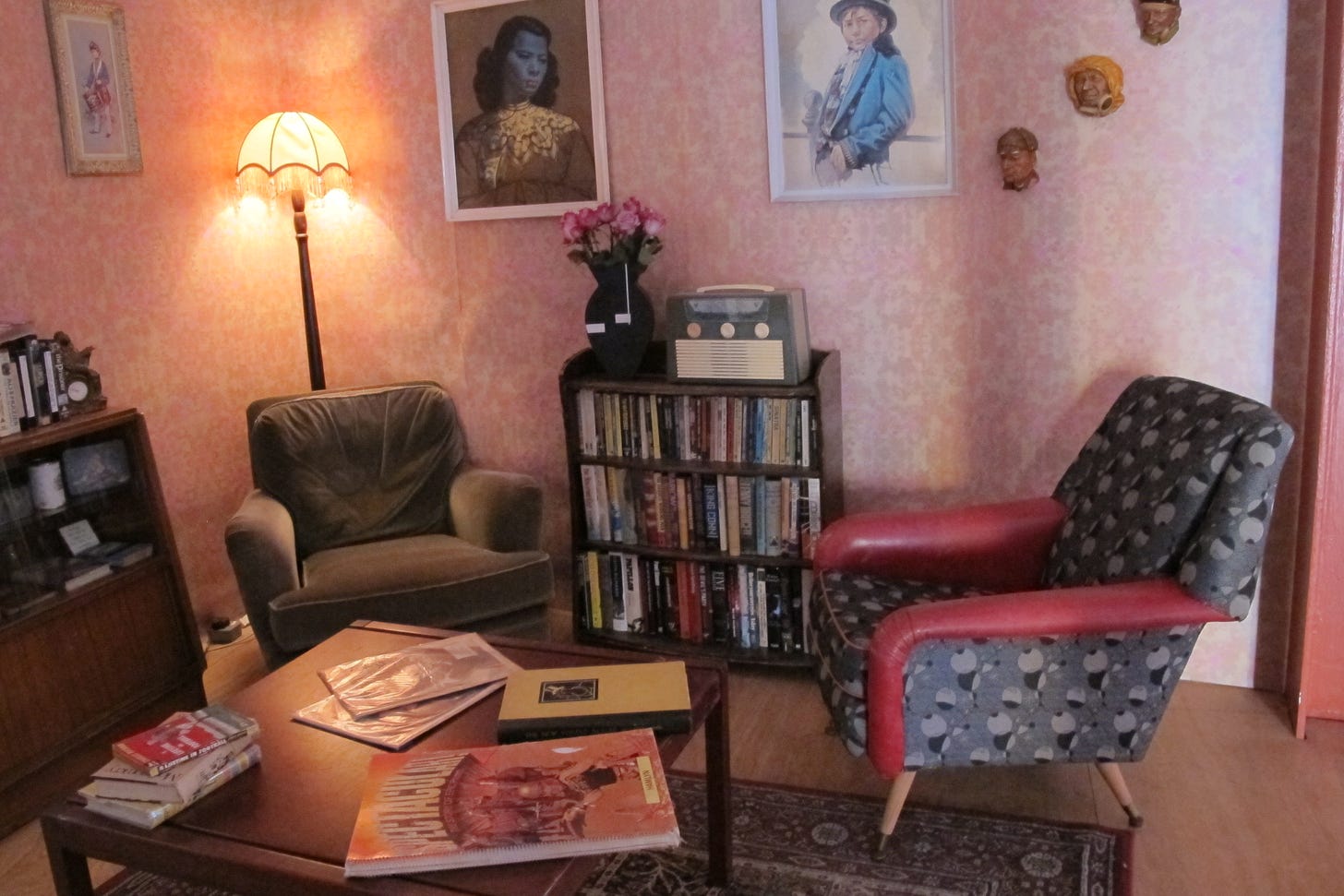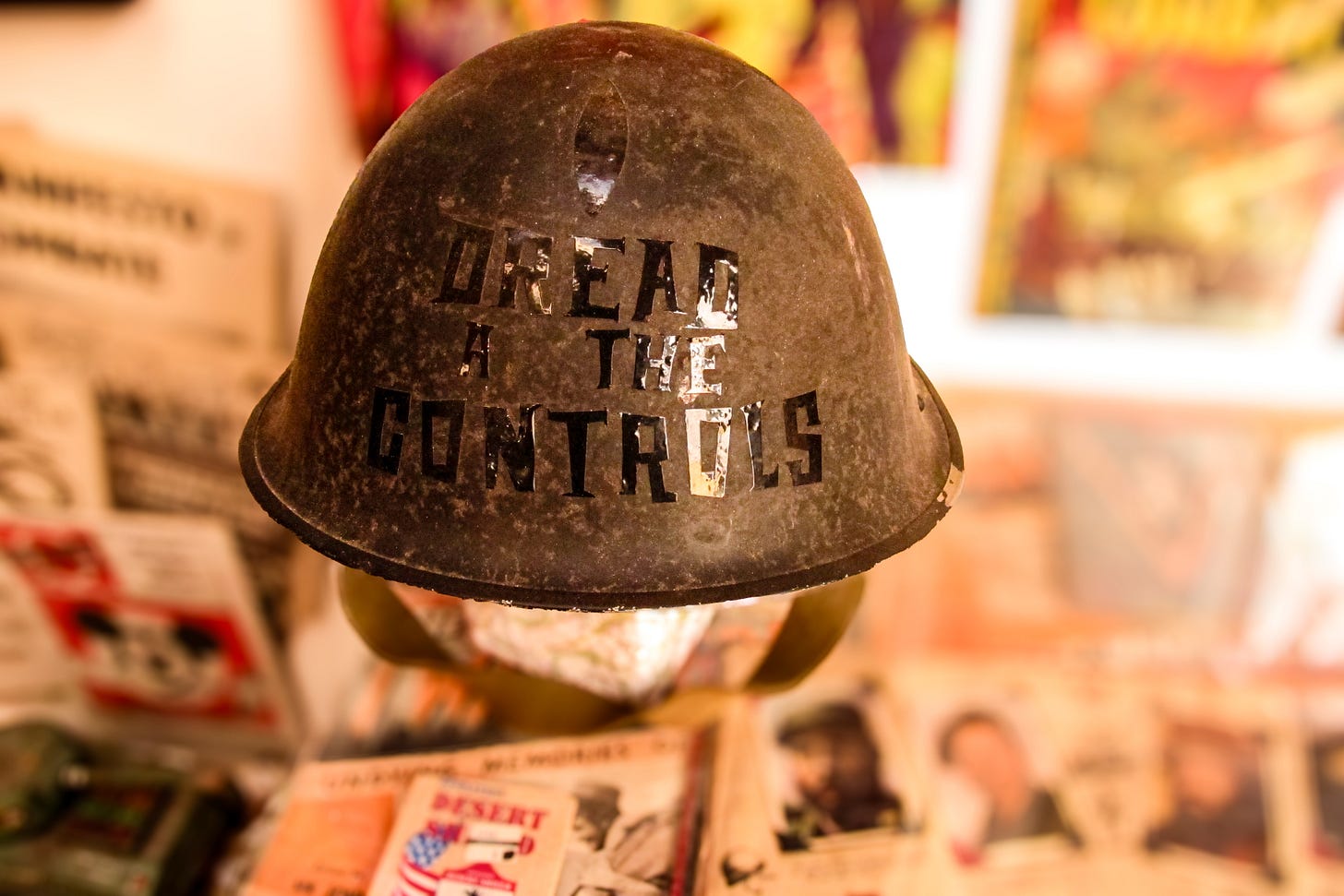Mick Jones has a copy of Interview signed by Andy Warhol. I have the Evening Express autographed by TV Smith
The Rock 'n' Roll Public Library was not a library. It was much more than that.
If you put aside the idea that nostalgia is a sickness, there’s something beautiful about Mick Jones’s Rock ’n’ Roll Public Library. Or rather, there was. If you haven’t been, too bad. It’s closed now, and it’s going to look even better in retrospect. You should have gone. Never mind. Maybe it’ll come back. It has before.
What was it? Let’s reminisce. It wasn’t, despite the name, a library. There were books in there, and fanzines, and toys, and video cassettes … in short, all kinds of shit. You could, if you wanted, play a video. You could pick a record and listen to it in a Woolworth’s-style listening booth. But you couldn’t check anything out, except in the colloquial sense. There were lots of things to check out. And checking out, increasingly, means taking a picture on your phone as proof. I checked out a lot of things, because I went twice. The second time, I forgot my phone and felt disabled, but I had a camera, so I still existed. I took pictures to remember the memorabilia.
We’ll get there. First, the business of getting to the RRPL. It was in a historic area of London, off Denmark Street, which used to be London’s Tin Pan Alley, and still houses a number of guitar shops. I recommend Peter Watts’ book, Denmark Street: London’s Street of Sound, but if you’re too visual to read, have a look at the cine-film of David Bowie wandering around. In the film, a smiling Bowie is filmed leaving Central Sound studio and going to La Gioconda coffee bar where, in happier times, he used to hang out with Marc Bolan. A lot of great things happened at Central Sound. The Kinks recorded You Really Got Me there, the Rolling Stones … and cue the image of swirling newspapers.
Those things don’t happen so much these days in Denmark Street. It’s less of a working environment for the music business, more of a destination. You can, if you’re feeling gullible, stay in the room that used to house the Sex Pistols, and admire Johnny Rotten’s daubings on the wall. Would that give you the authentic feeling of being a punk rock pioneer in 1970s London? Well, not entirely. As Glen Matlock told Peter Watts, the rehearsal room they acquired at no 6 (which previously housed Badfinger) was insalubrious. “We got it for £5 a week. It was a dump, the khazi was filthy. If we wanted a bath we had to go to Oasis on Endell Street.”
Different times. Since Crossrail and the redevelopment of Tottenham Court Road tube, the whole area around Denmark Street has been remodelled. Naturally, I’m nostalgic for the Astoria, a fine old music venue that was demolished to make way for the new trains, and I pine for the tonsorial economy of Mr Topper’s barber shop. But it’s not all negative. The trains are good. And the area around the foot of Centre Point, the concrete loofah previously known as “London’s Empty Skyscraper”, has been made into a space that almost works. Certainly there are a lot of tourists recording their bewilderment, which is pretty much the definition of a successful city.
OK, I’m going in. For the record, I’m combining my two visits into one. On both occasions, I felt conflicted. I wanted to stay, and I wanted to go. I’m sure that’s how Mick Jones designed it. In my fantasy visit, I wanted to ease into the armchair beneath the Tretchikoff blue lady and watch one of Mick’s videos. Maybe The Servant, or Scully, or Eastenders, 3 January 1993 (“The New Year brings problems for Frank and Pat, and hope for Sharon”). As a fanzine editor, I could have stared at the wallpaper forever, and not just to admire the explosive beauty of the titles from the early years of punk, which had no agenda beyond energy and action. Grangemouth’s The Next Big Thing is there, and the front cover has the Rezillos, Star Wars, The Dictators, Clash, Pistols and the Blue Oyster Cult. Or, there’s Jungleland, edited by future Waterboy Mike Scott, ruminating about Iggy, Bowie, the Velvet Underground, the Stranglers, Springsteen, the Blue Oyster Cult (again!) and Richard Hell (“genius is Hell”).
What else? I learned something. There’s sheet music for The Pretty Things’ Midnight To Six Man, which explains the line in The Clash’s best song, White Man In Hammersmith Palais (“Midnight to six man/for the first time from Jamaica”). Of course, the lyric also paraphrased the poster for an all nighter featuring Dillinger, Delroy Wilson, Ken Boothe and Leroy Smart, but it was Joe Strummer’s genius to knit these two things together. Further evidence of Strummer’s skill is evident from Jones’s handwritten lyric for the song I’m So Bored With You. Strummer retooled the song as the anthemic I’m So Bored With The USA, which was topical in 1977, and is moreso now. And while we’re on the Hard Rock Cafe tip, there are various great T-shirts, and a mannequin dressed in Mick’s clothes; red shirt, leather jacket, collar up.
I can’t go on. I will go on. Have you noticed, or is it just me, that the presenters on the Antiques Roadshow are getting younger? They’d take a lot of Mick’s stuff, though much of it wouldn’t look out of place at The Best Car Boot Sale … Ever. That Beethoven bust? I’ll give you two quid. The Coronation Street jigsaw that makes Stanley Ogden look like James Dean? Another level of genius. And I can’t fault the curatorial juxtaposition of the Georges, Best and Harrison (the 3rd and 5th Beatles). Does Humphrey Bogart belong next to Alan Ball? I can’t see why not. And what does he have in common with the Cuban revolution sticker album, or those pulp Commando comics, or the racks of magazines, from Attitude to Curious Facts, to Bookmaker and Betting Office? Christ, remember newsagents? They were great.
I’m struggling to say, because it seems so obvious, and I have my own trunks of junk, Tupperware tubs of punk badges, ephemera, autographed magazines. (Mick has an issue of Interview-signed by Andy Warhol. I have, or had, the Evening Express signed by TV Smith).
A question, then. Since we’re talking rock ’n’ roll, I’ll quote Greil Marcus reviewing Bob Dylan’s Self Portrait. “What is this shit?” Answer: it’s the shit of our lives, the stuff we had to struggle to find, the stars we used to guide ourselves, the haircuts we stole, the stances we took, the songs we sang. It’s all of our yesterdays colliding in a traumatic coma moment where everything flashes past in a vortex of lost context. It’s the analogue past, when Things mattered and everything wasn’t available all the time, cheating oblivion. It’s a kaleidoscope of everything we’ve ever done, everything we’ve ever been.
It is. It was.
As Ray Davies said when his beloved Arsenal left Highbury: “I miss the inconvenience”.





Reminds me of Andy Warhol’s Time Capsule boxes. Evidence of an existence, really.
You know how I can relate!